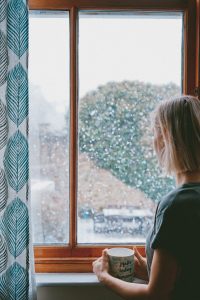You wake up to your alarm and you are snuggly warm in bed. You know what comes next as it is the dead of winter. You rush out of bed to find your work clothes all the while standing on your tip toes shivering.
You grab your cup of coffee and reluctantly head to the car in the dark and shiver as you wait for the frost to melt from your windshield.
Driving to work you hear on the radio about how this is the warmest day of the week. You get through your day at work only to walk to the car in the dark again. You drive home, turn on the lights to your place and get something to eat. You cuddle up on the couch under a blanket while watching your television show that is on every Wednesday night.
You fall asleep on the couch and when you wake, you begrudgingly head up to your room. You know the covers are going to be cold at first, but you end up falling asleep soundly.
Sound familiar?
The winter months can bring about many feelings. For some, the excitement of snowboarding season is enough to make the mundane days pass. For others, the lack of sunlight exposure can cause what is called Seasonal Affective Disorder (SAD). As a mental health professional, this term means more than just “the winter blues.”
SAD is actually a type of depression that is a result of a changing of seasons.
I want to use this space to talk a little more about SAD and how it differs from the winter blues and what you can do to make yourself feel better over the next few winter months.
SAD diagnoses are formed first by someone having met all the criteria for major depressive disorder while coinciding with particular seasons for at least two years. For a SAD diagnosis, the seasonal depression episodes must be more frequent than non-seasonal depression episodes.
With the criteria being so intense for a SAD diagnosis, one can imagine that it is not diagnosed frequently.
Most people who have symptoms similar to SAD without the major depressive symptoms are experiencing what is called the “winter blues.”
So why does this happen?
There are quite a few theories out there about why our moods can shift to the level of depression during seasonal times of year. One theory revolves around neurotransmitter levels. Due to a lack of sunlight in the winter, the brain’s pineal gland produces extra melatonin.
Our brains produce melatonin every evening around dark which helps aid in that sleepy feeling we get. With an increase in melatonin and a decrease in serotonin, dopamine, and norepinephrine, it is suggested that some people tend to feel less motivated and energetic.
Connected to the melatonin theory, the circadian rhythm theory points toward the idea that during the months when the sun rises later and sets earlier that our internal clocks go out of whack. This causes some people to be what is called “phase-early” where their brain releases melatonin too early in the evening and some people to be called “phase-delayed” where the melatonin is released too long into the day.
The most interesting theory behind SAD and the winter blues is that it could have been a survival mechanism for our ancestors.
When winter would strike and it was unbearably cold, the idea of hibernating similar to the animals makes sense for humans as well.
The increase in melatonin could have been a way of keeping humans safe from the cold and helped conserve energy for hunting during the day.
So how do you combat the winter blues or SAD?
Research presents several tips on what to do to help yourself feel better during the winter months.
1. Work on your diet to support your serotonin levels. I have to admit that I had to really research this one because to my knowledge, no food actually boosts serotonin, and my research proved I was right. Some foods that contain tryptophan can assist in increasing the synthesizing of serotonin, but cannot actually formulate it. Carbohydrates can spike serotonin levels, but that typically only lasts a few hours.
In order to have a serotonin diet that works, you have to focus on strategic carbohydrate intake. That essentially means mixing in healthy carbohydrates, like fruit, potatoes, and root vegetables with proteins and to eat proteins that are high in tryptophan, a building block for serotonin production. Some examples of this type of diet can be found here.
2. Consider taking supplements (consult your doctor first). Supplements like vitamin D and fish oil can help boost your mood if taken correctly.

3. Recognize that this is a time of year to be recharging. As hard as it may seem to think about when you are freezing waiting for the bus, shift your thoughts toward the cozy blankets and the sweatpants you will put on when you get home. Allow your brain to overproduce the melatonin and fall asleep earlier. Caving into some of those natural hibernation tendencies can actually make you feel better.
4. Shocker among shockers, exercise more. Even just moving more can help increase some of the chemicals in your brain like dopamine, nonrepinephrine, and endorphins making you feel better. Two tips I came across that were a little less obvious included selecting workout clothes that are brightly colored as a way of shifting your mood as well as going to a gym with windows or doing indoor workouts near a window to get some extra sunlight.
5. Make a to-do list and check things off the list. I like this one mostly because I a subscriber of to-do lists and finding research that backs up the idea that it can make you feel good to check something off a list was awesome. When your dopamine levels are lower, you lose your love of adventure and start to feel bored and unaccomplished. Having a list of small and large things to do around your house or office gives you an opportunity to re-invest in your life. According to some studies, the simple act of crossing something off your to-do list because you accomplished it gives your brain a dose of dopamine.
6. Invest in lights for some indoor light therapy. Light therapy has been studied and determined to be helpful for those who may be on the more serious side of the scale of the winter blues and definitely helpful for those with SAD. It is important to be well informed about what type of light to purchase, when to use it, and for how long. My research states that you typically want to use the light for a half hour in the beginning of your day and to keep your eyes open.
If you decide to try light therapy on your own (it is recommended that you at least consult your family doctor), you can find questionnaires online to help determine the best course of action in terms of how long to use your light. Please note that if you have bipolar disorder it is not recommended you use light therapy without consulting your therapist/psychiatrist as it can possibly trigger mania.
7. Seek professional help. Try and find a therapist who specializes in depression. As always, I recommend finding someone who is licensed and for this particular disorder or list of symptoms, I recommend someone who practices CBT. Cognitive Behavioral Therapy (CBT) is one of the best methods to treat winter blues/seasonal depression because it can provide strategies.
It is pretty common to hear people talk about feeling down during the cold winter months, but it does not necessarily mean you need to get treatment. The differences between winter blues and SAD are significant and should never be treated lightly.

There are some subtle changes you can make if you feel like you may have a case of the winter blues, and there are big steps you should take if you feel like you may have SAD.
I hope this was helpful and please feel reach to reach out with any questions! Stay tuned for more info about particular mental health disorders as I try to debunk them!



Share your thoughts